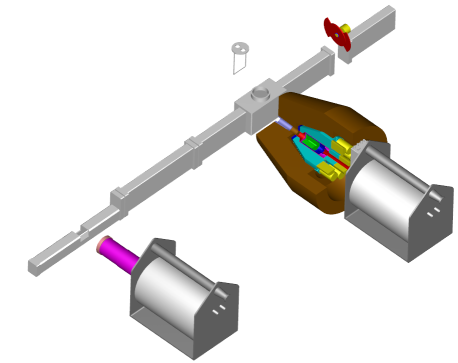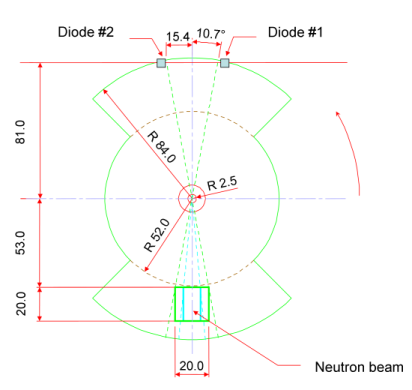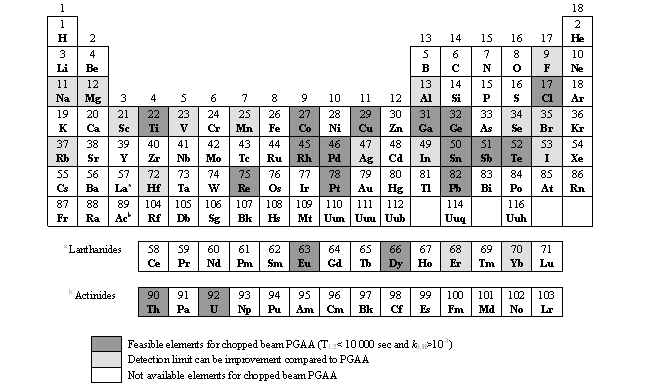Chopped-beam PGAA
Introduction
In prompt-gamma activation analysis (PGAA), radionuclides are also produced during the irradiation. Their decay gamma-rays appear in the gamma-spectrum along with the numerous prompt peaks. Since many of the decay peaks are among the most intense peaks of the spectrum, they are widely utilized in the routine analysis.
Modulating neutron beams with a beam chopper enables the investigation of time-dependent processes following neutron capture, such as the emission of decay gamma-radiation from short-lived nuclides. Thus, in chopped-beam PGAA, the beam is periodically opened and closed, and two spectra are recorded alternately. The decay peaks are determined in the beam-off phase, while the prompt peaks appear during the beam-on phase.
When investigating the short- and medium-lived nuclides, the use of a guided, cold-neutron beam PGAA facility has advantages over standard NAA, especially in combination with beam chopping. In particular, at the PGAA facility of the Budapest Neutron Center,
- the epithermal activation is completely avoided,
- the longer sample-to-detector distance and the collimation (see the figure below) results in a small solid angle which, in turn, keeps the true coincidence effects low and also helps to reduce the dead-time effects,
- the sample is in a fixed position throughout the experiment, which allows even the investigation of nuclides with ms-long half-lives and eliminates uncertainties related to the sample repositioning,
- the half-life does not limit the precision, since the on-line counting can be prolonged as long as needed to attain suitable statistical accuracy,
- the use of a beam chopper avoids the spectral interferences and the high Compton-baseline due to prompt peaks, by separating the decay and the prompt events on the basis of their different time-behavior.

The Budapest PGAA-NIPS facility with the beam chopper
Instrumentation
Recently
the chopper instrumentation of our facility has been upgraded. A
redesigned electronic unit controls the chopper and provides gating
signals to route the events. Two alternative data acquisition chains
were set up for chopped-beam measurements: one of them is based on a
XIA digital spectrometer, while the other option uses analog components
only.
The chopper disk has four quadrants of equal size; two of them are open, while the two others are coated with a polymer containing enriched 6Li as a neutron absorber. The outer radius of the disk is 84.0 mm, while the frequency of rotation can be adjusted up to 60 Hz. The distance of the sample from the chopper disk is 375 mm. The proper timing is ensured with a pair of diodes.

The chopper disk has four quadrants of equal size; two of them are open, while the two others are coated with a polymer containing enriched 6Li as a neutron absorber. The outer radius of the disk is 84.0 mm, while the frequency of rotation can be adjusted up to 60 Hz. The distance of the sample from the chopper disk is 375 mm. The proper timing is ensured with a pair of diodes.

The layout of the beam-chopper disk
Analytical application
The
goal of the chopped beam technique is to lower the detection limit and
increase the selectivity of the PGAA method for certain elements. A
systematic series of measurements on many short-lived nuclides is in
progress to identify the elements where the detection limits could be
substantially improved. Although the detectable peak area for the decay
peaks is only of that in the continuous in-beam activation, the
suppression of the background can reach several orders of magnitude,
depending on the matrix. The overall signal-to-noise ratio is therefore
higher.
Encouraging results were found so far for elements F, Na, Al, Sc, V, Mn, Br, I, Ag, In, Hf, and Yb measured with the present system. However, the majority of the 40–50 nuclides principally amenable to this technique produce weak decay lines only, making less effective the efforts to lower their detection limits in the routine analysis.

Encouraging results were found so far for elements F, Na, Al, Sc, V, Mn, Br, I, Ag, In, Hf, and Yb measured with the present system. However, the majority of the 40–50 nuclides principally amenable to this technique produce weak decay lines only, making less effective the efforts to lower their detection limits in the routine analysis.

Determination of nuclear data
The
chopped-beam PGAA technique can became an important
methodological link between the PGAA and the instrumental NAA,
hence the same nuclear values are determined with completely different
approaches. This can help to reveal possible discrepancies in the
commonly used cross-section data. Partial gamma-ray production
cross-sections and k0-factors were obtained for 15 radionuclides, including 20F, 24Na, 28Al, 38mCl, 38Cl, 56Mn, 46Sc, 80Br, 82Br, 127I, 179m1Hf, 187W, 108Ag, 110Ag.We
applied successfully the technique for the investigation of nuclides
important in transmutation and nuclear waste management. Among these,
the partial gamma-ray production- and the total capture cross sections
of 129I, 99Tc were obtained, while the measurement on 241Am is also foreseen.
References
- Zs. Révay, T. Belgya, L. Szentmiklósi, G. L. Molnár: Prompt gamma activation analysis using a chopped neutron beam, J. Radioanal. Nucl. Chem. 264 (2) (2005) 277-281
- G. L. Molnár, Zs. Révay, L. Szentmiklósi: New perspectives for very short-lived neutron activation analysis, J. Radioanal. Nucl. Chem. 262 (1) (2004) 157-163
- L. Szentmiklósi, Zs. Révay, T. Belgya: Measurement of partial gamma-ray production cross-sections and k0-factors for radionuclides with chopped-beam PGAA, Nucl. Instr. Meth. A 564 (2006) 655-661
- L. Szentmiklósi, Zs. Révay, T. Belgya: An improved beam chopper setup at the Budapest PGNAA-NIPS facility, Nucl. Instr. Meth B 263 (2007) 90–94
- T. Belgya, Z. Révay, L. Szentmiklósi: Determination of Thermal Neutron Capture Cross Sections Using Cold Neutron Beams at the Budapest PGAA and NIPS Facilities, Proc. 12nd International Conference on Capture Gamma-Ray Spectroscopy and Related Topics, University of Notre Dame, Indiana, USA, Edited by Aprahamian, A. (AIP 2005)

